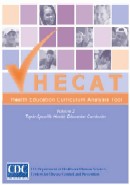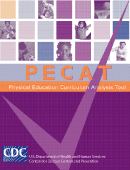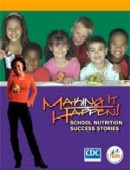





|

|

Make a Difference: Key Strategies to Prevent Obesity
Take Action
Strategies 5-10
Schools can build a strong foundation that will enable them to effectively
promote physical activity and healthy eating, as well as other
health-enhancing behaviors. The first four strategies help schools develop a
tailored approach that meets their specific, local needs and interests; earn
the support and commitment of the school community; use the insights gained
from scientific research; and emphasize teamwork and collaboration to
maximize effectiveness and efficiency.
5. Implement a high-quality health
promotion program for school staff.Staff wellness programs provide opportunities for school staff members
to participate in health assessments, nutrition classes, physical
activity programs, and other health promotion activities. These
opportunities can contribute to improvements in physical and mental
health outcomes; increases in morale, productivity, and positive role
modeling; and decreases in absenteeism and health insurance costs.
 SCHOOL EMPLOYEE WELLNESS: A Guide for Protecting
the Assets of Our Nation's Schools.*
Developed by the Directors of Health Promotion and Education (DHPE) with
CDC support, Protecting Our Assets is designed to help schools,
districts, and states develop comprehensive school employee wellness
programs. This resource provides guidance for obtaining program support,
developing a school employee wellness team, using existing data to
optimize a new or existing program, and implementing policies and
practices to support employee wellness. SCHOOL EMPLOYEE WELLNESS: A Guide for Protecting
the Assets of Our Nation's Schools.*
Developed by the Directors of Health Promotion and Education (DHPE) with
CDC support, Protecting Our Assets is designed to help schools,
districts, and states develop comprehensive school employee wellness
programs. This resource provides guidance for obtaining program support,
developing a school employee wellness team, using existing data to
optimize a new or existing program, and implementing policies and
practices to support employee wellness.
6. Implement a high-quality course of
study in health education.Health education provides formal opportunities for students to acquire
knowledge and learn essential life skills that can foster physical
activity and healthy eating. Taught by qualified teachers, quality
health education includes instruction on essential topics that protect
and promote physical, social, and emotional health and safety and
provides students with ample opportunities to practice health-enhancing
skills. State-of-the-art health education features a sequential
curriculum consistent with state or national standards and adequate
instructional time.
 CDC's Health Education Curriculum Analysis Tool (HECAT). This tool can help
school districts, schools, and others conduct a clear, complete, and consistent
analysis of health education curricula based on the
National Health Education
Standards and CDC’s Characteristics of Effective Health Education Curricula.
The HECAT results can help schools select or develop appropriate and effective
health education curricula and improve the delivery of health education. It can
also be used to identify where revisions might be needed in an existing locally
developed curriculum. The HECAT can be customized to meet local community needs
and conform to the curriculum requirements of the state or school district.
CDC's Health Education Curriculum Analysis Tool (HECAT). This tool can help
school districts, schools, and others conduct a clear, complete, and consistent
analysis of health education curricula based on the
National Health Education
Standards and CDC’s Characteristics of Effective Health Education Curricula.
The HECAT results can help schools select or develop appropriate and effective
health education curricula and improve the delivery of health education. It can
also be used to identify where revisions might be needed in an existing locally
developed curriculum. The HECAT can be customized to meet local community needs
and conform to the curriculum requirements of the state or school district.
7. Implement a high-quality course of study in physical
education.Physical education is the cornerstone of a comprehensive approach to
promoting physical activity through schools. All students, from
pre-kindergarten through grade 12, should participate in quality
physical education classes every school day. Physical education not only
provides opportunities for students to be active during the school day,
but also helps them develop the knowledge, attitudes, skills, behaviors,
and confidence needed to be physically active for life.
 CDC’s
Physical Education Curriculum Analysis Tool (PECAT). This tool enables educators to evaluate physical education curricula
based on the extent to which the curricula align with national
standards, guidelines, and best practices for quality physical education
programs. The PECAT can be used to identify where revisions might be
needed in a locally developed curriculum or to compare strengths and
weaknesses of published physical education curricula being considered
for adoption. For those schools without a physical education curriculum,
the PECAT provides a vision of what should be included in a high-quality
written physical education curriculum. CDC’s
Physical Education Curriculum Analysis Tool (PECAT). This tool enables educators to evaluate physical education curricula
based on the extent to which the curricula align with national
standards, guidelines, and best practices for quality physical education
programs. The PECAT can be used to identify where revisions might be
needed in a locally developed curriculum or to compare strengths and
weaknesses of published physical education curricula being considered
for adoption. For those schools without a physical education curriculum,
the PECAT provides a vision of what should be included in a high-quality
written physical education curriculum.
8. Increase opportunities for students to
engage in physical activity.
The school setting offers multiple
opportunities for all students, not just those who are athletically
inclined, to enjoy physical activity outside of physical education classes:
walking to and from school, enjoying recess, physical activity clubs and
intramural sports programs, and having classroom lessons that incorporate
physical activities. These opportunities help students learn how to weave
physical activity into their daily routines.
 CDC’s
KidsWalk-to-School.
This manual provides guidance for schools and communities on how to
create an environment that supports safe walking and bicycling to
school. It includes educational materials to help promote walking to
school and suggests strategies for communities to overcome barriers to
walking to school. CDC’s
KidsWalk-to-School.
This manual provides guidance for schools and communities on how to
create an environment that supports safe walking and bicycling to
school. It includes educational materials to help promote walking to
school and suggests strategies for communities to overcome barriers to
walking to school.
CDC’s VERB™ Campaign Materials.
This national, multicultural campaign encourages children ages 9–13 to
increase their participation in physical activities. The VERB™ Campaign has
a variety of colorful educational materials that schools can use to help
promote physical activity among youth.
9. Implement a quality
school meals program.Each school day, millions of students eat one
or two meals that are provided as part of the federally funded school meals
program. These meals have a substantial impact on the nutritional quality of
students’ overall dietary intake and provide a valuable opportunity for
students to learn about good nutrition. CDC supports the efforts of the USDA
to ensure that meals served through the National School Lunch Program and
School Breakfast Program are safe, nutritious, and balanced.
 Changing
the Scene: Improving the School Nutrition Environment.*
This USDA Team Nutrition tool kit, developed with technical assistance
from CDC, provides guidance and ready-to-use resources designed to help
schools implement a comprehensive and consistent approach to promoting
healthy eating among students. The kit addresses the entire school
nutrition environment and includes guidance on serving and marketing
quality school meals in a pleasant eating environment. Many other school
meal guidance tools are available from the Team Nutrition Web site. Changing
the Scene: Improving the School Nutrition Environment.*
This USDA Team Nutrition tool kit, developed with technical assistance
from CDC, provides guidance and ready-to-use resources designed to help
schools implement a comprehensive and consistent approach to promoting
healthy eating among students. The kit addresses the entire school
nutrition environment and includes guidance on serving and marketing
quality school meals in a pleasant eating environment. Many other school
meal guidance tools are available from the Team Nutrition Web site.
10. Ensure that students have
appealing, healthy choices in foods and beverages offered outside of
the school meals program.
 Most
schools offer foods and beverages to students through a variety of
channels outside of the federally regulated school meals program:
vending machines, school stores, concession stands, after-school
programs, fundraising campaigns, and class parties. These offerings have
dramatically increased student access to high-fat or high-sodium snacks
and non-nutritious, high-calorie beverages. Although federal regulations
on these foods and beverages are limited, many states, school districts,
and schools are establishing strong policies and innovative marketing
practices to promote the sale of healthier foods and beverages. Most
schools offer foods and beverages to students through a variety of
channels outside of the federally regulated school meals program:
vending machines, school stores, concession stands, after-school
programs, fundraising campaigns, and class parties. These offerings have
dramatically increased student access to high-fat or high-sodium snacks
and non-nutritious, high-calorie beverages. Although federal regulations
on these foods and beverages are limited, many states, school districts,
and schools are establishing strong policies and innovative marketing
practices to promote the sale of healthier foods and beverages.
Making It Happen: School Nutrition Success Stories.
This resource, developed by CDC and the USDA’s Team Nutrition with
support from the U.S. Department of Education, describes six strategies
that schools have implemented to improve the nutritional quality of
foods and beverages offered on campus. It also tells the stories of 32
schools and school districts across the country that have successfully
implemented these strategies.
 Nutrition Standards for Foods In Schools: Leading the Way Toward Healthier Youth.*
This
report, published by the Institute of Medicine (IOM), provides nutrition guidance
for schools seeking to implement or improve upon their current wellness policies.
The report includes the IOM’s recommendations about nutrition standards for foods
offered in competition with federally reimbursable meals and snacks.
Nutrition Standards for Foods In Schools: Leading the Way Toward Healthier Youth.*
This
report, published by the Institute of Medicine (IOM), provides nutrition guidance
for schools seeking to implement or improve upon their current wellness policies.
The report includes the IOM’s recommendations about nutrition standards for foods
offered in competition with federally reimbursable meals and snacks.
Back to Top
| * |
Links to non-Federal organizations are provided solely as a service to our users. Links do not constitute an endorsement of any organization by CDC or the Federal Government, and none should be inferred. The CDC is not responsible for the content of the individual organization Web pages found at this link. |
|

|
